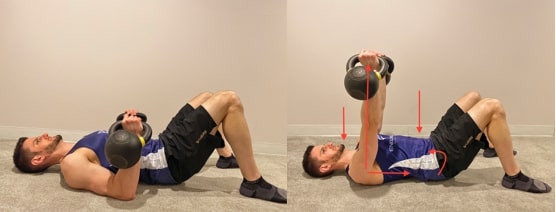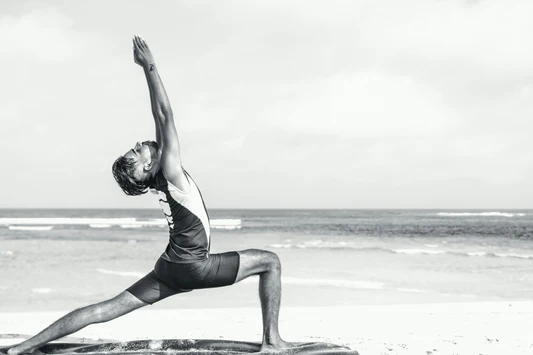In previous articles we discussed the importance of posture stability and introduced some basic techniques to help correct postural defaults and improve the function of the muscles that work to maintain proper posture.
In our daily lifestyles there will be activities that are not as static and as simple as sitting still at a desk and will require the ability to translate the principles of posture into more dynamic and advanced movements.
Carrying weighted items, pulling weight and pressing weight overhead are all movement demands that occur in training regimens for athletic performance, fitness and also daily life.
The exercises below are some more advanced movements that will help train the use of proper stabilizers and avoid compensation from accessory muscles.
When muscles required for movement compensate for stability, imbalances occur. These drills can help to correct these imbalances.
Tall Kneeling Cervical Rotation with Anterior Load

Purpose: Reduce accessory activation in the cervical musculature with loaded upper extremities and restore rotation mobility in the cervical region.
- Assume a tall kneeling position while holding a weight in the front of your body. The weight should be moderate, enough to challenge the posture but not overbearing. 10-15# weights are usually good to start with this exercise.
- Keeping the arms straight, push your shoulder blades down and back.
- Focus on your shoulder blades preventing the weight from pulling your shoulder and neck forward.
- While holding this position, rotate your head to the left and then to the right.
- Repeat 10-15 times each way.

Proper positioning shown to the left and improper positioning shown to the right. Notice to the right the rounded shoulders and kyphotic posture, forward head and disengaged scapula compared to the position shown to the left.
Tall Kneeling Cervical Rotation with Posterior Load

Purpose: Reduce accessory activation in the cervical musculature with loaded upper extremities and restore rotation mobility in the cervical region.

Proper alignment for the positioning in tall kneeling.
Repeat the same procedure for the anterior load method except hold the weight behind your back.
- The weight behind the back will provide more of a stretch to the anterior shoulder girdle and chest.
- Keep the arms straight and push the shoulder blades down and back.
- Lighter weight might be required for this method to start compared to front position.
- Repeat the head turns 10-15 times each way.
Floor Press with Abdominal Bracing and Head Turns


Purpose: Use scapula and core stabilization with loads through the upper extremities to reduce cervical accessory activation for restoration of rotation mobility.
- Lying on your back with your knees bent, hold two weights of moderate resistance in each hand.
- Starting with the back of your arms on the floor, press the weight straight up while avoiding arching of the low back.
- At the top position, maintain the shoulder blades squeezed while turning your head to the left and then to the right.
- Continue to also focus on drawing the belly inward. Lower the weight down.
- Repeat while holding the weight and turning your head to the right and left 5 times each then rest.
Bent Over Row with Cervical Retraction

Purpose: Ensure proper cervical stabilization when pulling resistance through the upper extremities.
- Standing in a hip hinge position with two weights of moderate resistance on the floor, grab a weight in each hand.
- With the arms straight, ensure that the torso is neutral without lumbar extension. Squeeze the shoulder blades down and back while pulling the weights to the mid section.
- While pulling, keep the cervical spine neutral by drawing the chin in to complete a chin retraction movement.
- Hold the cervical position during the pull and lowering phase of the row. Avoid cervical extension compensation.
- If these positions cannot be maintained, lower the weight.
- Repeat for 15 reps.

Improper bent over row positioning. Notice the compensation at the lumbar with excessive extension as well as cervical extension.
Unilateral Farmer’s Hold with March

Purpose: Ensure postural integrity with one upper extremity loaded in the carry position. This exercise also works on translating core and pelvis control in the single leg position as a pre requisite to a farmers carry with walking.
- Standing with one weight of moderate resistance in one hand, focus on pushing your shoulder blades back and down, chin drawn in and belly drawn in.
- Avoid lumbar arching and slouching in the thoracic region.
- While maintaining this posture, raise one leg up as high as you can while avoiding slouching.
- Lower the leg down and repeat with the other leg.
- Continue to alternate and repeat 10 time each leg.
Overhead Weighted Hold with March

Purpose: Ensure posture and core control with an overhead static form of resistance while moving through the lower extremities.
- Standing in the same position as the single arm farmers hold, move the weight to the overhead position.
- Focus on the pointing the knuckles towards the ceiling, elbow locked in extension and pushing the shoulder down towards the armpit.
- Avoid shrugging the shoulder with the weight towards the ears and also avoid arching the lumbar region.
- Focus on drawing the belly inwards and keeping your pelvis level.
- While maintaining this posture, slowly raise one leg up as high as you can without losing the posture.
- Focus on keeping the arm overhead and avoid the weight from moving forward.
- Repeat alternating 10 times each leg.

Improper positioning for the overhead hold with marching. Notice the compensation at the lumbar spine with extension, knee flexion in the stance leg and weighted arm forward from the center of mass.
To review, these exercise are more advanced forms of training postural integrity, which ensures proper muscle sequencing patterns and positioning of the cervical thoracic and lumbar spine.
Some of these concepts are derived from functionalmovement.com which is a movement based diagnostic system used to evaluate and treat musculoskeletal dysfunction.
Learning to use the proper stabilizer muscles in the scapula, cervical region, torso and pelvis, help to achieve proper positioning, especially under loads and avoid compensatory movement patterns.
The use of resistance such as weights can offer feedback to promote the proper posture as the body has a stimulus to work against. Sometimes a light to moderate load is required to stimulate the neuromuscular system for the proper response.
Too often we can find ourselves using accessory muscles and mobilizers to compensate for stability, example being the cervical musculature. When this happens we lose mobility such as rotation, extension and flexion.
This loss of mobility can cause aberrant stress onto the spine resulting in localized neck pain back pain, muscle spasm, soft tissue restrictions and possible nerve related symptoms.
About The Author:
Michael St. George PT, DPT has been practicing for 10 years primarily in the outpatient and orthopedic setting. He works for a physical therapist owned private practice based in the greater Philadelphia area and surrounding suburbs. Mike is certified through Functional Movement Systems for FMS, SFMA and FCS which consist of screens and testing used to measure movement quality and performance. Mike also has experience with working with numerous surgeons and physicians from the Rothman institute. Currently he works primarily with ACL, meniscus and post surgical recovery and sports injuries, return to sport testing and performance, running evaluation and re training and hand and upper extremity conditions.


